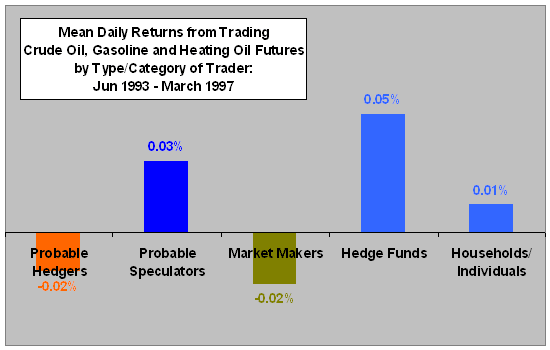Does the profitability of futures traders depend on risk-taking, private information or luck? In the January 2010 revision of their paper entitled “Determinants of Trading Profits of Individual Traders: Risk Premia or Information”, Michaël Dewally, Louis Ederington and Chitru Fernando investigate success factors for traders in the crude oil, gasoline and heating oil futures markets. They exploit detailed daily open interest data for specific large and mid-size traders (from the Commodity Futures Trading Commission, as augmented by the Department of Energy) accounting for about 70% to 80% of these three futures markets. This detailed data enables analytical segmentation of traders into eleven types, consolidated into four categories: (1) hedgers, (2) speculators, (3) market makers and (4) others. Using detailed data for a final sample of 382 traders over the period June 1993 through March 1997 (46 months), they conclude that:
- Average gross trading profits of hedgers (speculators) are significantly negative (positive). It appears that net long (short) positions by hedgers push futures prices above (below) expected future spot prices, creating profit opportunities for speculators.
- For probable hedgers, the average unweighted (weighted) annualized trading profit is -3.80% (-4.27%).
- For probable speculators, the average unweighted (weighted) annualized trading profit is 10.40% (8.18%).
- Across all categories, specific trader gross profit tends to be higher when the trader takes the position opposite that of hedgers in aggregate.
- Across all categories, specific trader gross profits tend to be higher when long (short) markets in backwardation (contango).
- Among the eleven trader types defined, hedge funds have the highest average gross profit, due almost entirely to the risk absorption service they provide hedgers. Hedge funds make up 18.8% of the sample of 382 traders but account for 40% (3.4%) of those with significantly positive (negative) gross trading profits.
- Excluding their revenue from the bid-ask spread, market makers lose money. Market makers account for 18.1% of the total sample but 36.2% of those with significantly negative gross trading profits.
- There is no evidence that larger traders have an information advantage.
- Except for households/individuals, speculator gross profitability tends to increase with portfolio turnover.
The following chart, constructed from data in the paper, compares average daily gross (before trading frictions) trading profits as a percentage of total open interest for the three major identified trader categories (hedgers, speculators and market makers) and for two trader types within the speculator category. It shows that speculators on average earn a reward for absorbing risk from hedgers and that hedge funds are more efficient in capturing this reward than are households/individuals.

In summary, evidence from detailed, but somewhat aged data, indicates that a typical futures speculator makes money by taking a position opposite that of hedgers in aggregate.
Note that the definitions of hedger and speculator are more granular and analytical than those inferred from the “commercial” and “non-commercial” categories in the Commodity Futures Trading Commission’s Commitments of Traders (COT) reports. Traders can therefore exploit the paper’s findings only approximately using these reports. Note also that futures markets may have changed since 1993-1997 (for example, more crowded with speculators).